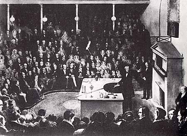Nearly 210 years ago, the son of a poor blacksmith read a book he was repairing while performing his duties as an apprentice in a bookbinder’s shop. Marcett’s Conversations on Chemistry captured the imagination of the young teenager, Michael Faraday. He delighted in learning of recent discoveries in the fledgling field of science. That scientific interest led him to a position at the Royal Institution of Great Britain, where Faraday made many great scientific discoveries of his own; one of which changed our world, forever. However, he is most renowned for his ability to communicate science to the public.
 Imagine the interest and apprehension people of that era might have held regarding a new discovery of the time: the fiery sparks of the phenomenon called “electricity”. Audiences were enamored at Faraday’s ability to use common language to explain the nature of the unnerving electrical current, and also engage them in the delight of many profound scientific discoveries of the time. Michael Faraday was indeed a masterful science communicator. Queen Victoria informally called him…. Wizard; a man who caused us to experience the truest beauty of the Creation.
Imagine the interest and apprehension people of that era might have held regarding a new discovery of the time: the fiery sparks of the phenomenon called “electricity”. Audiences were enamored at Faraday’s ability to use common language to explain the nature of the unnerving electrical current, and also engage them in the delight of many profound scientific discoveries of the time. Michael Faraday was indeed a masterful science communicator. Queen Victoria informally called him…. Wizard; a man who caused us to experience the truest beauty of the Creation.
Other science communicators have answered the call to be providers of common sense and understanding of scientific innovations. At the end of World War II, the term atomic energy entered the public lexicon, leaving most of the public fearful and apprehensive of anything tagged, “nuclear.” Dr. Hubert Alyea at Princeton was engaged by the United Nations to visit 88 countries, explaining the nature and positive possibilities of atomic energy to millions in attentive audiences. Often compared to Faraday, Dr. Alyea took the role Wizard II, and served as the key role model for the Disney movie; The Absent Minded Professor.
In the 1950’s, when the Sputnik satellite began the space race and subsequent pursuit of science learning, the public turned to yet another renowned science communicator, Don Herbert; better known as television’s Mr. Wizard. For five decades, generations of youngsters were inspired to learn the “science of everyday living,” from the third great Wizard.
The current holder of the Wizard title was mentored by two of those famed science communicators. Alyea taught him chemistry and the art of being a scientific raconteur. Mr. Wizard trained him to follow in his footsteps in television. In 1995, at the Royal Institution of Great Britain, near the memorial of Wizard I, Michael Faraday, the torch was passed. Wizard IV was given the challenge of carrying the science communicator’s,” light of illumination.”

